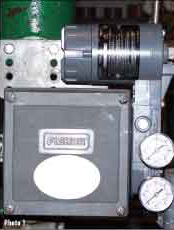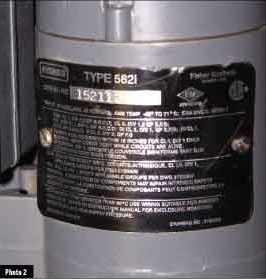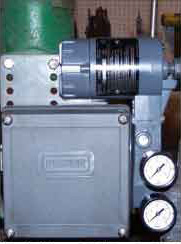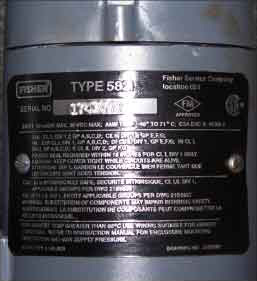Buyers of salvaged, remanufactured, refurbished or new surplus electrical instrumentation for use in hazardous locations (including chemical process plants, refineries, and other industries/applications which are classified as hazardous) need to exercise caution in their instrumentation purchases. Doing so is especially important given the increased market for these items, which experts estimate at $100 million for the process industry and growing. There are several factors responsible for the rapid growth in this market: industry pressure for cost containment (maintenance budgets and small, local capital projects), increased overseas competition and the ongoing closure of North American chemical and hydrocarbon processing facilities.

Photo 1
Len Frier’s May/June 2002 IAEI News article noting that “beauty is only skin deep” could not be more appropriate when dealing with the above types of resold electrical instrumentation,1 especially when those instruments are to be used in hazardous (classified) locations as defined by the National Electric Code2 and the Canadian Electrical Code 3 with regulatory requirements such as Occupational Safety and Health Administration (OSHA) 1910.307. 4 This article is one way of generating process industry awareness of the potential safety risk posed by this instrumentation as well as the risk of regulatory non-conformance. By better understanding how salvaged, remanufactured, refurbished and new surplus electrical instrumentation is certified, buyers can better ensure that their safety management programs meet their needs, helping to provide safer work environments.

Photo 2
There is little process industry awareness of the fact that some nationally recognized testing laboratory (NRTL) instrument certifications may no longer comply with the defined standards to which they were originally certified. Such instruments include salvaged, remanufactured, refurbished or re-marketed as new surplus, even though the reselling entity leaves the original manufacturer’s nameplate containing an NRTL approval mark on the instrument. To date, buyers and installers have assumed that they have purchased replacement-in-kind instruments when, unfortunately, they may not be replacement-in-kind. These purchases require increased scrutiny, including management of change (MOC) evaluations, to better ensure that plant design standards and regulatory requirements are met.
This article will outline steps buyers can take to ensure that their salvaged, remanufactured, refurbished or new surplus electrical instrumentation meets requirements for use in hazardous (classified) locations. Before delving into these solutions, it is important to clarify some definitions.
Definitions
Reconditioned refers to any form of salvaged, refurbished, or remanufactured instrumentation. Transfer of instrument ownership has typically taken place during a reconditioning process with limited, if any, traceability associated with the instrument’s prior application, environmental conditions, handling, maintenance history, use of OEM parts during repairs, etc.
New Surplusis defined as unused current or obsolete instrumentation, which:
- May or may not still be in the original packaging
- May have been in end user, distributor or other intermediary inventory since original manufacture
- May have been previously installed, calibrated and subsequently removed and repackaged without actually being started up.
- May have had multiple ownership transfers without the instrument ever having been used
More traceability typically exists for new surplus instrumentation than for reconditioned instrumentation, but it is still usually limited. With new surplus instruments subjected to the scenarios outlined in the bullets above, the opportunity exists for unknown changes or hidden damage over the typically lengthy time and handling between original manufacture and subsequent resale.
Product Certification

Photo 3
OSHA safety standards contain requirements for “approval” (i.e., testing and certification) of certain products by a NRTL. These safety standards are found in Title 29 of the Code of Federal Regulations (29 CFR), and the provisions for NRTL certification are generally in Part 1910 (29 CFR Part 1910).4
OSHA recognition of an NRTL is an acknowledgement that the organization has the necessary qualifications to perform safety testing and can “properly certify” the specific products covered within its scope of recognition.4
Properly certified generally means:4
1. The product is labeled or marked with the registered certification mark of the NRTL.
2. The NRTL issues the certification for a product covered within the scope of a test standard for which OSHA has recognized it.
3. The NRTL issues the certification from one of its sites (i.e., locations) that OSHA has recognized.
NRTL Certification Positions
Of the NRTLs OSHA recognizes for the testing and certifying of instrumentation for use in hazardous (classified) locations, FM Approvals, LLC, a member of the FM Global Group has, to date, established its formal position regarding their approval certification mark for refurbished or new surplus product.
“It is FM Approvals’ position that only the original manufacturer of the approved product or an FM Approved remanufacturer whose facilities are part of the FM Approvals follow-up audit program, can remanufacture a product and reissue the FM Approvals certification mark. Any suggestion, practice or inference to the contrary is wrong and must cease.”
Further: “Any salvaged, remanufactured or new surplus electrical instrument cannot be labeled or relabeled as FM Approved for use in a classified hazardous location unless the refurbishing/new surplus supplier entity is audited and approved by FM Approvals, LLC, for that specific type of instrument.”
“Absent the above being met, the device can carry the FM Approvals certification only if the product has been resubmitted and approval granted by FM Approvals. Failure to follow these guidelines will invalidate the FM Approvals certifications. In such instances the FM Approvals certification mark shall be permanently removed from the product (including the nameplate).” 5

Photo 4
To date, the above position has not been well understood, especially in industries having plant/process unit areas classified as hazardous due to the potential presence of ignitable or combustible chemicals, hydrocarbons or dust, as defined by NEC,2 CEC,3 et al.
The typical perception is that an electrical/electronic instrument, once NRTL approved at the factory, remains NRTL approved for the life of the device. This perception is a major concern and results from the original equipment manufacturer (OEM) nameplate usually being left on reconditioned or new surplus instruments by a supplier which may not be audited or approved by the NRTL to do so. This is typically the situation even though there may be other non-OEM markings identifying the instruments as having been reconditioned. See example photo comparisons below.
Thus, both suppliers and purchasers may incorrectly perceive that reconditioned instruments meet engineering or maintenance specifications that require NRTL approval to sustain plant design standards and to comply with regulatory safety requirements. The FM Approvals position is clear that such is not the case; i.e, instruments are no longer approved, and its NRTL approval labeling should be removed. Without NRTL certification, these devices are no longer approved as safe for use in hazardous (classified) locations, thus presumably increasing the risk of a catastrophic accident. A management of change (MOC) evaluation would be necessary if these devices were considered for use in a location classified as hazardous.
Although the use of non-approved instrumentation may not yet have resulted in a catastrophic, explosive incident to date, it may be naïve to assume an accident will not happen in the future.
Typically, safety experts have embraced the philosophy that “just because there hasn’t been an accident in the past does not mean that the combination of situations required to cause an accident will not occur in the future.” However, in addition to the safety issue, the potential regulatory non‑compliance certainly creates additional financial exposure should an incident occur, especially if the incident involves personal injury or death.
Solutions
Within a process safety management program (PSM), including process hazard analysis (PHA), emphasis is needed to ensure hazard identification; adequate risk assessments; detailed attention to instrument specifications by engineering, purchasing and maintenance; supplier qualification, safety training; and the development of appropriate processes for identification and abatement of any currently installed, non-compliant devices.
Where NRTL approved devices are required for use in hazardous locations, confirmation of NRTL approval is recommended. In other words, if reconditioned or new surplus devices have been or are currently being purchased, one may need to perform an appropriate risk/regulatory compliance assessment and identify all devices that are no longer NRTL approved.
The following steps offer a straightforward methodology for identification and abatement.
Identification:
- Ask the purchasing department to provide a list of the suppliers having sold reconditioned or new surplus instruments that are normally NRTL approved (excepting field inspection and certification if such service is available from the NRTL and the number of required field inspections would be small.)
- Fully qualify each supplier by requiring them to provide up-to-date, NRTL signed documentation demonstrating that the supplier is compliant with the appropriate NRTL position on such reconditioned or new surplus instruments.
- Identify hazardous (classified) locations and tag numbers where potentially non-compliant instruments are currently installed (including warehouse spares inventory).
- Walk down the instruments and identify any instruments suspected to be reconditioned or new surplus. Record each instrument’s serial number.
- Working with the OEM or the OEM’s local distributor, use the instrument serial numbers to identify the original shipping destination when purchased new.
- If the shipping destination of the instrument, when purchased new, is different from the current end user’s destination, thereby demonstrating prior ownership, then the instrument may need re-certification (unless documented to have been purchased from an NRTL audited and approved re-conditioner or new-surplus supplier).
Abatement:
- Recertify reconditioned or new surplus instruments that are no longer NRTL approved. Use a qualified supplier for each instrumentation type and manufacturer; i.e., must be an NRTL audited and approved facility within the NRTL’s scope of recognition by OSHA.
- Start with the warehouse and have any reconditioned or new surplus instruments that are no longer NRTL approved, re-approved by an appropriate NRTL audited facility.
- Use these re-approved instruments (or use new, approved instruments) as rotational replacements for the non-compliant field instruments.
- Continue removing, re-approving and replacing non-compliant field instruments on a rotational basis until full abatement is achieved.
Sustaining:
- Ensure that purchasing, engineering, operating and maintenance personnel work only with qualified and documented suppliers of reconditioned or new surplus instrumentation for use in hazardous locations (NRTL audited and approved by instrument type and manufacturer).
- Emphasize the requirements for sustaining NRTL approved reconditioned or new surplus instrumentation and that a management of change process (MOC) will be required when a visual replace-in-kind is not truly an equivalent technical replace-in-kind.
Maintenance MOC
As noted, the MOC process should receive increased emphasis to ensure technical equivalency, especially since many reconditioned instruments are often extolled by a non-OEM supplier as “equivalent to factory specifications.”
Such devices may look identical externally, but they may no longer be identical technically. An example is a supplier of reconditioned or new surplus instruments leaving an original manufacturer’s nameplate on a device (containing the original NRTL approval certification mark), and the supplier is not audited or approved by the NRTL. In such circumstances, an MOC evaluation is necessary for installation into a hazardous (classified) location.
For devices where NRTL approval is in question, an efficient method for verification is to review the serial number with the OEM or OEM distributor. They can identify the original shipping destination when purchased new. If the device has changed ownership, there is a high probability that the device was resold as either new surplus or reconditioned.
Supplier Qualification
End users or intermediate resellers of instrumentation can easily and efficiently ensure that reconditioned or new surplus instruments that require NRTL approvals are purchased from NRTL audited and approved entities by requiring the following:
- Obtain signed, NRTL authored documentation from suppliers of salvaged, refurbished, remanufactured or new surplus electrical/electronic instrumentation that certifies they are audited and approved by the NRTL to apply, re-apply or leave in place an NRTL approval label
- Verify that NRTL authored documentation lists the specific manufacturer instrument types for which the supplier is audited and approved
- Require suppliers to provide their NRTL audit frequency, including ongoing submittal of NRTL signed documentation following each successful follow-up audit
Summary
FM Approvals, LLC, an OSHA accredited NRTL, has gone on record with respect to its approval validation of previously certified products that are subsequently resold into the marketplace after being salvaged, refurbished, remanufactured or resold as new surplus.
Across the process industry, reconditioned and new surplus instrumentation has been incorrectly perceived as sustaining its NRTL approval for use in hazardous (classified) locations, resulting in a growing presence of such non-approved devices. The proliferation of electrical/electronic instruments that are no longer NRTL approved increases the statistical possibility of a catastrophic, explosive incident.
By better understanding and addressing the issues now, appropriate actions and emphasis can be incorporated into hazard identification and process safety management programs, resulting in safer work environments.
1 Frier, Len: “What Electrical Inspectors Don’t See,” IAEI News (May/June 2002); available fromwww.iaei.org
2 ANSI / NFPA 70-1996,National Electrical Code
3 CSA Standard C22.1-98, Canadian Electrical Code
4 U.S. Department of Labor, Occupational Safety & Health Administration
5 Martell, Robert L.: Assistant Vice President, FM Approvals Director, FM Approvals LLC










Find Us on Socials